Introduction
The work of Erzen (2011, pp. 125-131) explains that the development of architectural styles and methods of innovation in the various regions of the world is often the result of responses to the natural environment (Erzen 2011, pp. 125-131). This does not limit itself to aesthetic differences in design as seen in the opposing design elements of buildings from Japan as compared to those within Europe but instead encompasses unique architectural manifestations of internal and external innovative differences that impact not only the look of the building but how it functions as a living environment (Agudo 2010, pp. 1-33). This can have long-term influences on the development of architecture within a region and as such can be considered a means by which architectural development responds to the natural environment (Agudo 2010, pp. 1-33).
This paper will thus examine how naturally hot temperatures found within the Middle East have influenced the development of Islamic architecture. What you have to understand is that the Middle East has an environment whose temperatures often reside in the median range of 45 degrees Celsius. As such this creates a unique set of architectural challenges to ensure that a living environment is not only capable of protecting its residents from the heat but dissipating it when necessary. This is to prevent the creation of buildings that can only be described as human ovens. Due to the information presented this paper thus presents the assumption that the design elements within Islamic architecture are meant to address the issue of heat within Middle Eastern environments and would manifest themselves in design elements related to cooling, shade, and water.
The Wind Catcher (ملقف malqaf)
One of the developments in Islamic architecture that has come about as a direct result of the environment and climate is the windcatcher (ملقف malqaf). Usually, a wind catcher takes the form of a tower that is 3 to 4 stories high with several openings placed at the top of the tower to let fresh air into a shaft that directs the cool air downwards into a home (Al-Qahtany 2009, pp. 435-457).
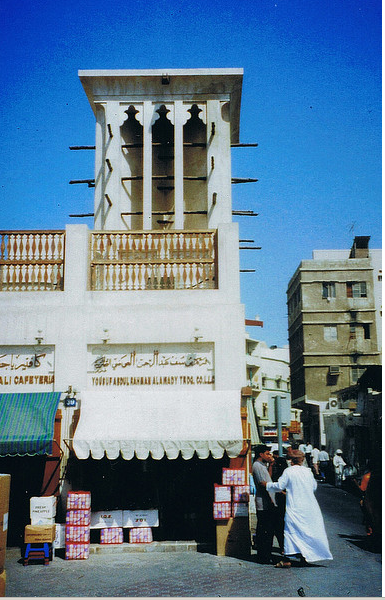
Windcatcher is located within the Souk market in Dubai (Dry Climate)
This can be considered an early form of architecturally based ventilation that relies on differences in temperature gradients to chill the interiors of various homes. This is due to cool air that is directed downwards from the tower pushing the warm air that is present within the building upwards. The warm air subsequently escapes through various ventilation shafts to the outside of the house resulting in a much cooler interior. This creates a cooling effect which ensures that heat does not build up within the domicile that could potentially cook the people inside (Al-Qahtany 2009, pp. 435-457).
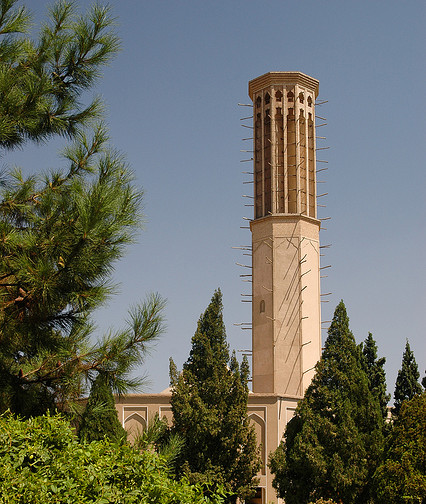
Yadz building in Iran (Hot-Wet Climate)
While, in recent years, the necessity of wind catchers has been waning due to the development of artificial means of environment control such as air conditioners, the fact remains that the traditional design elements of a tall tower attached to a low lying building still continues to manifest itself in various aspects of Islamic architecture (Pourjafar, Pourjafar & Shahinrad 2011, pp. 564-572).
Mashrabiya (مشربية)
The Mashrabiya (مشربية) is a projecting window aperture that is commonly found in the second story of homes within the Middle East. Interestingly enough, within the past 20 years this design element has been commonly isolated to large and opulent residences due to the invention of the air conditioner (Al-Qahtany 2009, pp. 435-457).
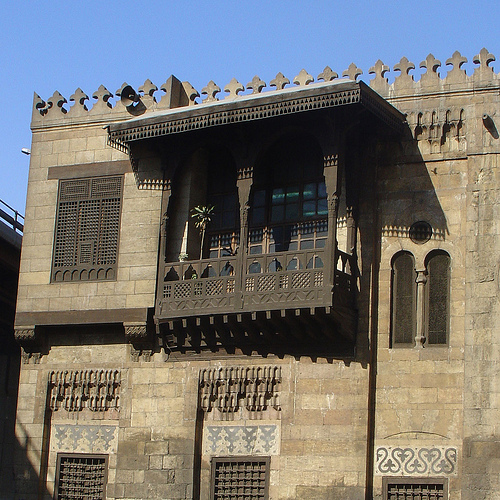
Mashrabiya is located in a Mosque in Egypt (Hot-Dry Climate)
While decorative in its aesthetic design its intended purpose was to cool the interiors of houses by letting the cool air from the streets into the home. The latticework seen in the window served a dual purpose wherein the large holes at the top of the screen let in cool air while the smaller holes at the bottom of the screen let out warm air. This is a similar design conceptualization to the windcatcher that also works on the principle of temperature variances in order to influence the internal environment of a building.
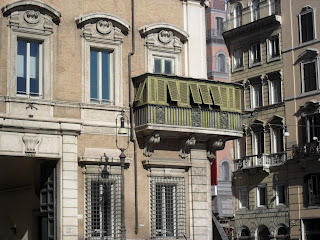
Mashrabiya retrofitted onto an Islamic building in Rome (Hot-Wet Climate)
Another interesting aspect of the Mashrabiya ( مشربية ) is that its subsequent projecting design actually provides a certain degree of protection and shade for the lower ground floor windows of a home thus adding to the ongoing theme of implementing design elements to ensure the maximum amount of temperature control within a building (Al-Qahtany 2009, pp. 435-457).
Predominant Use of Building Materials that are Light in Color
Another way Islamic architecture was influenced by the local environment and climate can be seen in the overwhelming use of white sandstone, various types of grey stones, or other such types of building materials that are primarily bright in color. The reason behind their usage can be seen in the study of Al-Qahtany (2009, pp. 435-457) which examined the reflective properties of building materials and how such aspects can be utilized in order to create a form of free temperature control (Al-Qahtany 2009, pp. 435-457).

Islamic Fort in Agra, India (Hot-Wet Climate)
Al-Qahtany (2009) explains that bright colors such as white, yellow, or light gray can reflect sunlight away from a building whereas dark colors such as black or brown have the tendency to absorb sunlight. Thus the prevalent use of light-colored building materials in Islamic architecture can be considered as yet another means of temperature control due to the way in which such materials help to prevent the inside of a building from overheating.
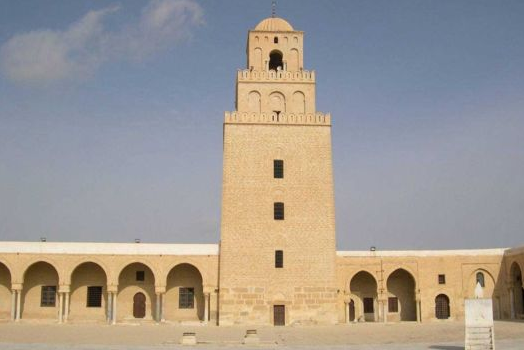
Islamic Mosque in Tunisia (Hot-Dry Climate)
It must be noted that various studies have indicated that the color scheme utilized in Islamic architecture may have been due to the general availability of lightly colored building materials as compared to their darkly colored counterparts. While such a debate continues to this very day this paper will choose not to delve into it since it significantly departs from the information that is currently being presented.
Geometric Patterns
One of the relatively minor influences that the local environment has had on the development of Islamic architecture has been the development of angled or slanting areas and various geometric patterns meant to create areas of shade or maximize protection from the sun. This is not to say that it cannot be considered a significant development however it is something that is not unique to Islamic architecture and can be seen in many architectural examples throughout the world. I consider this to be a relatively minor influence by the local environment and as such has little merit for further examination or explanation.
Sehan (صحن )
The last traditional design element that will be presented is the Sehan (صحن ) which means courtyard. An examination of past and present Islamic architecture reveals that courtyards are prominently featured in various homes and buildings. This is not isolated to their aesthetic appeal instead such environments played yet another role in controlling the temperatures within a home (Al-Qahtany 2009, pp. 435-457).
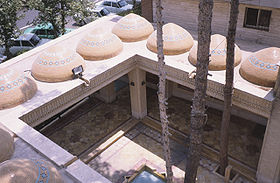
Sehan is located in Saudi Arabia (Hot-Dry Climate)
A courtyard in the Middle East possessed not only plants but also happened to be an area that was often the coolest part of the home due to the presence of numerous areas for shade as well as served as a source of breezes during most parts of the year (Al-Qahtany 2009, pp. 435-457). This creates an area where most of the habitants could go to cool off and it also served as the “lung” of the building since the breezes that came in through the courtyard served as a means of cooling and ventilating other parts of the house.
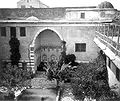
Sehan is located in Damascus, Syria (Hot-Wet Climate)
It must also be noted that in the courtyards of some of the more affluent members of Islamic society were fountains that served a dual purpose of not only providing a means for ablutions but also helping to cool the air as it flowed into the courtyard.
Present Day Influences
An examination of the responsiveness of Islamic architecture to the environment and climate would not be complete without at least a relatively minor examination of modern-day influences. Within the past few years, it can be seen that Islamic architecture within the Middle East has continued to evolve and has adapted to new developments in modern-day technological processes through the implementation of solar-powered arrays on various homes and buildings. This is due to the abundant solar energy within the region and should prove to be a design element that will be incorporated into the greater whole of Islamic architecture within the next few decades.
Reference List
Agudo, M 2010, ‘Late-Antique and Early Medieval Hispanic Churches and the Archaeology of Architecture: Revisions and Reinterpretation of Constructions, Chronologies and Contexts’, Medieval Archaeology, vol. 54, no. 1, pp. 1-33.
Al-Qahtany, H 2009, ‘Islamic architecture as a reflection of functionalism and interactionism: conceptual origins in culture and sociology’, Contemporary Arab Affairs, vol. 2, no. 3, pp. 435-457.
Erzen, J 2011, ‘Reading Mosques: Meaning and Architecture in Islam’, Journal Of Aesthetics & Art Criticism, vol. 69, no. 1, pp. 125-131.
Pourjafar, M, Pourjafar, A, & Shahinrad, M 2011, ‘Evolution of towers and minaret of islamic architecture from qabus tower to Malaysian Petronas twin towers (KLCC)’, International Journal Of Academic Research, vol. 3, no. 1, pp. 564-572.